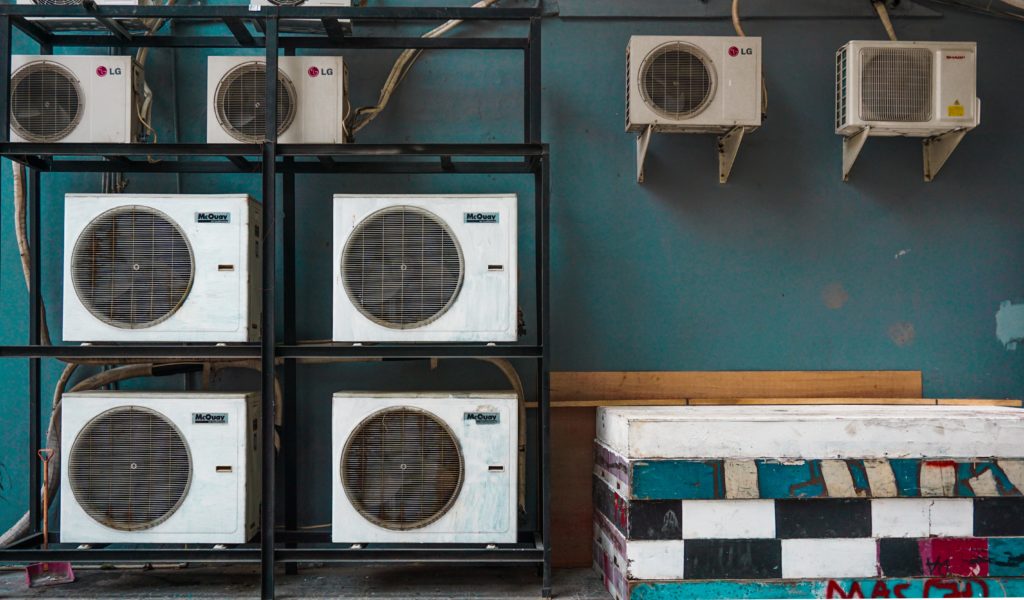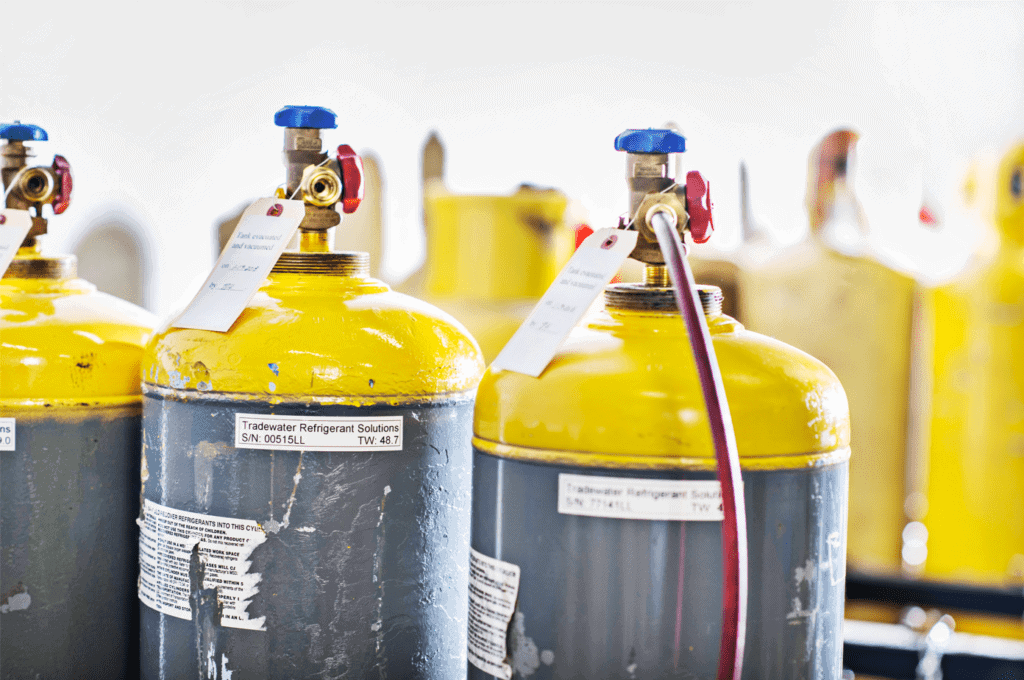Get paid to fight climate change.
(Hint: Look at your air conditioner….)
Your company may be sitting on some of the most potent greenhouse gases ever created: old refrigerants. These climate-warming gases often go unnoticed in chillers, air conditioning, and refrigerated systems.
We’ve teamed up with Intuit, the global financial platform, to help more businesses take positive steps to reduce their carbon emissions.
Ensure that your climate commitment includes monitoring these greenhouse gases – and get paid to see them destroyed or recycled.

Get paid for your existing refrigerant, with no-cost shipping
Includes chlorofluorocarbon (CFC) refrigerants
Free recovery services of refrigerants in building chillers and other systems
Includes chlorofluorocarbon (CFC) refrigerants
Up to 50% off on recovery, reclamation, and recycling services
Includes hydrochlorofluorocarbons (HCFCs) and hydrofluorocarbon (HFC) refrigerants

How it Works
Tradewater is an EPA-certified organization reclaimer with the technical expertise to handle refrigerant safely and responsibly. Unlike others who purchase refrigerant, however, we do this work to fight climate change.
We first aggregate the dangerous greenhouse gases we collect. Depending on the refrigerant type, we either destroy the gases through incineration or send them through a regulated recycling process.
By selling your refrigerant to us, your company makes a positive, measurable impact on the environment. You can be sure that the gases will be destroyed and never leak into the atmosphere.

Make the world better while making money.
Since 2016, Tradewater has prevented the equivalent of over 6.2 million tons of carbon dioxide from being released to the atmosphere. Your company can join this work and help us destroy even more greenhouse gases—while getting paid.

Intuit Climate Action Marketplace
The Intuit Climate Action Marketplace is a one-stop-shop for sustainability solutions for small businesses.
The Intuit Climate Action Marketplace empowers small businesses to reduce their impact on the environment by selecting sustainable solutions. With one click, small businesses can take immediate action to replace high carbon-emission activities with more sustainable solutions across energy, travel, office supplies and other categories. Collectively, the choices made by millions of small businesses today can accelerate our global response to the climate crisis.
We are proud to participate in Intuit’s Climate Marketplace, an initiative driving significant impact. We’re all doing our part—and now you can, too.
Permanence
Emission reductions are considered permanent if they are not reversible. In some projects, such as forestry or soil preservation, carbon offset credits are issued based upon the volume of CO2 that will be sequestered over future decades—but human actions and natural processes such as forest fires, disease, and soil tillage can disrupt those projects. When that happens, the emission reductions claimed by the project are reversed.
The destruction of halocarbon does not carry this risk. All destruction activities in Tradewater’s projects are conducted pursuant to the Montreal Protocol , which requires “a destruction process” that “results in the permanent transformation, or decomposition of all or a significant portion of such substances.” Specifically, the destruction facilities Tradewater uses must meet or exceed the recommendations of the UN Technology & Economic Assessment Panel , which approves certain technologies to destroy halocarbons, including the requirement that the technology achieve a 99.99% or higher “destruction and removal efficiency.” Simply put, this means that Tradewater’s technologies ensure that over 99.99% of the chemicals are permanently destroyed. During the destruction process, a continuous emission monitoring system is used to ensure full destruction of the ODS collected.
Accuracy
Some carbon offset projects necessarily rely on estimations or assumptions when calculating the emission reductions from project activities. Forestry projects, where developers make assumptions about the carbon that will be sequestered over future decades if trees are conserved, are a perfect example. Such projects sometimes result in an overestimation of the environmental benefit of the project.
Tradewater’s halocarbon projects avoid the issue of overestimation by consistently conducting extremely precise testing and measurement of the amount of refrigerant destroyed in each project.
Additionality
It is a basic requirement of all carbon offset projects that the underlying project activities are additional. “Additional” means that the projects would not happen in the absence of a carbon market. Tradewater’s halocarbon projects simply would not happen – and the gases would be left to escape into the atmosphere – without the sale of the resulting carbon offset credits. This is because there is no mandate to collect and destroy these gases. It is still permissible to buy, sell, and use halocarbons that were produced before the ban. There are other reasons halocarbon destruction projects are additional:
- There are no incentives or financial mechanisms to encourage halocarbon destruction. According to the International Energy Agency and United Nations Environment Program, “there is rarely funding nor incentive” to recover and destroy ozone depleting substances in storage tanks and discarded equipment. And collecting, transporting, and destroying halocarbons is time-intensive and expensive. The burden to collect and destroy these gases therefore remains prohibitive outside of carbon offset markets—meaning that if organizations like Tradewater do not do this work, nobody else will.
- Countries are not focused on the need to collect and destroy halocarbons. The Montreal Protocol has been celebrated as a success because of its production ban. This success, however, ignores the legacy gases produced before the ban and is a blind spot for government regulators. In the U.S., for example, the Environmental Protection Agency (EPA) developed a Vintaging Model in the 1990s to estimate the quantify of ozone depleting substances left in circulation. Based on the inputs and assumptions put into the model, the EPA predicted that no CFCs would be available for recovery beyond 2020 in the United States. But this prediction did not prove accurate. Tradewater has collected and destroyed more than 1.5 million pounds of CFCs globally in recent years and continues to identify thousands of pounds per week.
- International carbon accounting standards do not require corporations to measure or track emissions tied to halocarbons, and refrigerants are specifically excluded from Science Based Targets initiative (SBTi) commitments. These commitments derive from emissions reporting under the GHG Protocol, which requires companies to report on emissions only from new generation refrigerants, such as hydrofluorocarbons (HFCs), but does not establish any obligation to report inventories or emissions of refrigerants still in use, such as CFCs and HCFCs. All these factors combine to make Tradewater’s carbon offset projects highly additional. As Giving Green, an initiative of IDinsight, concluded: “Tradewater would not exist without the offset market, so this element of additionality is clearly achieved.” The case for additionality is not so clear for some other project types, such as forestry and landfill gas carbon projects. For example, some forests are already being conserved for their beauty, or for use as parks, and generate carbon offset credits only because those conservation efforts do not yet have full formal protection in place to avoid deforestation in the future. Similarly, methane from landfills can be used to make electricity or captured as compressed natural gas, thereby creating additional revenue streams to support the activities, beyond the sale of carbon credits.

